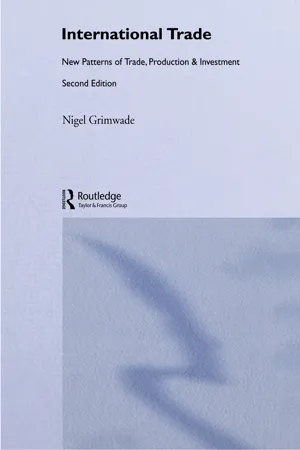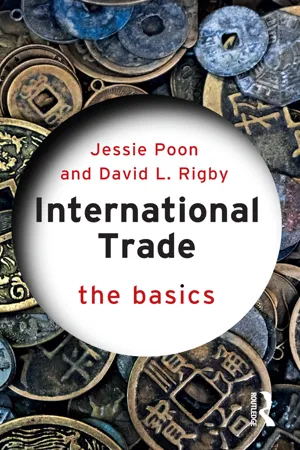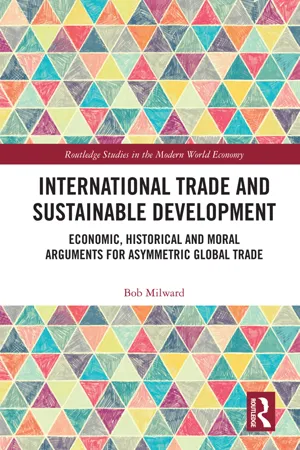Comparative Advantage vs Absolute Advantage
Comparative advantage refers to a country's ability to produce a good or service at a lower opportunity cost than another country, while absolute advantage refers to a country's ability to produce more of a good or service using the same amount of resources. Comparative advantage focuses on opportunity cost, while absolute advantage focuses on productivity.
7 Key excerpts on "Comparative Advantage vs Absolute Advantage"
- eBook - ePub
International Trade
New Patterns of Trade, Production and Investment
- Nigel Grimwade(Author)
- 2020(Publication Date)
- Routledge(Publisher)
...So long as each country possesses a comparative advantage in at least one activity, it pays to specialise in that activity and engage in trade. Differences in comparative costs are given by comparing the relative cost ratios existing in the two countries before trade. These express the cost of producing one unit of a particular good in terms of the number of units of the other good that must be forgone in order to do so. If we assume that all labour is employed in one or other activity, an extra unit of one good can only be produced by reducing output of the other. This way of expressing cost is what economists call 'opportunity cost' or the cost of something expressed in terms of opportunities foregone. We can see this by considering an example of two countries similar to that used to illustrate the principle of absolute advantage. Once again, each country is considered to have the same labour resources and to divide these equally between two activities. Cloth Wheat 000s 000s Country A 100 200 Country B 80 100 Total 180 300 In this case. Country A is more efficient at both activities. If, however, we measure the opportunity cost of producing each product in both countries, it will be apparent that A has a comparative advantage in wheat and B has a comparative advantage in cloth. In A, the production of an extra unit of wheat requires sacrificing 0.5 units of cloth, whereas in B, it requires sacrificing 0.8 units of cloth. Thus, A has a comparative advantage in wheat production. Turning next to cloth, the cost of producing an extra unit of cloth in A is 2 units of wheat and in B 1.25 units of wheat. So, B has a comparative advantage in cloth production. Note also that these pre-trade cost ratios for each country will give the pre-trade relative price ratios. Now, let us see what happens if both countries specialise in the product in which they enjoy a comparative advantage...
- eBook - ePub
The Theory of International Business
Economic Models and Methods
- Mark Casson(Author)
- 2016(Publication Date)
- Palgrave Macmillan(Publisher)
...It is a simple application of the principle of opportunity cost. It implies that products should be produced by individuals who have the lowest opportunity cost for that product in terms of the amount of other products that they could have produced instead. Comparative advantage also has a simple mathematical expression. Recall that worker 1 can produce either b 01 units of product 0 or b 11 units of product 1, and worker 2 can produce either b 02 units of product 0 or b 12 units of product 1. Worker 1 has comparative advantage in product 0 if b 01 / b 11 > b 02 / b 12, and comparative advantage in product 2 if the inequality is reversed, b 01 / b 11 < b 02 / b 12. If a worker is comparatively advantaged in one product then they are comparatively disadvantaged in the other. Comparative advantage is equivalent to relative opportunity cost. Suppose that worker 1 produces product 1; then their opportunity cost of product 1 in terms of product 0 is c 1 = b 01 / b 11, as noted earlier. Similarly worker 2’s opportunity cost of product 1 is c 2 = b 02 / b 12. It is cheaper for worker 1 to produce product 1 if c 1 < c 2, which implies that b 01 / b 11 < b 02 / b 12, that is, worker 1 has comparative advantage in product 1. Conversely, it is cheaper for worker 2 to produce product 1 if c 1 > c 2, which implies that b 01 / b 11 > b 02 / b 12, that is, worker 2 has comparative advantage in product 1. A distinction is often drawn between comparative advantage and absolute advantage. If worker 2 is more productive than worker 1 in product 1 then they may be said to have an absolute advantage in product 1, and if they are more productive in product 2 they may be said to have an absolute advantage in product 2. If they have an absolute advantage in both it might be said that worker 1 has an absolute advantage over worker 2. As noted above, absolute advantage alone is not sufficient to determine who does what, but it does have implications for how much they earn from what they do...
- eBook - ePub
- W. Charles Sawyer, Richard L. Sprinkle(Authors)
- 2020(Publication Date)
- Routledge(Publisher)
...CHAPTER 3 Comparative advantage and the production possibilities frontier Nature, by giving a diversity of geniuses, climates, and soils, to different nations, has secured their mutual intercourse and commerce as long as they all remain industrious and civilized. The industry of the nations, from whom they import, receives encouragement: Their own is also increased, by the sale of the commodities which they give in exchange. David Hume INTRODUCTION I n the previous chapter, we considered a number of aspects of international trade. We first showed that international trade occurs for the same reason that domestic trade occurs. Next we considered trade as a way for businesses to make a profit and for consumers to obtain lower-priced goods. This initial look at international trade showed that trade is driven by the existence of different prices for goods in different countries. The analysis to this point left one important question unanswered: why are the prices different? To answer this question, we first considered the theory of trade based on absolute advantage. Some countries can produce goods at a lower price because labor in that country is more productive in producing that particular good. Trade based on absolute advantage is deficient in some respects as a complete explanation of trade. To remedy these problems, we then considered the theory of comparative advantage. Countries have a comparative advantage in the production of goods where the opportunity cost of producing those goods is low. While the theory of comparative advantage is quite general, our discussion of the reasons for international trade is not complete. Specifically, we made an assumption in Chapter 2 that is not always realistic. In our previous analysis, we assumed constant costs. This is not an unreasonable assumption in many cases. However, you may recall from Principles of Economics that there are other cost conditions...
- eBook - ePub
International Trade
The Basics
- Jessie Poon, David L. Rigby(Authors)
- 2017(Publication Date)
- Routledge(Publisher)
...We keep things simple at first by assuming that trade costs, the costs of moving goods from one country to the other, are zero. Perhaps the two countries are neighbors! After some experimentation it should become clear that our two countries can benefit from trade if they each specialize in producing that commodity in which they have an absolute advantage. For example, if country A takes all its 75 workers and uses them to produce wine, the daily output would be equal to 75*4 = 300 units of wine. If country B specializes in cloth production, it could produce each day 50*3 = 150 units of cloth. After specializing, total output across our two countries has increased by 180 units of wine and 30 units of cloth. If shared between the two countries, this additional output represents the gains from trade. While Smith’s model of absolute advantage establishes the possibility of gains from trade, those possibilities arise only when different countries each possess absolute advantage in the production of at least one commodity. In this respect, Smith’s model provides a rather limited basis for trade: there are many countries that engage in trade that likely have no absolute advantages over the rest of the world. What drives these countries to trade? The answer rests on the concept of comparative advantage outlined by David Ricardo in his 1817 book On the Principles of Political Economy and Taxation. We develop the arguments of comparative advantage using the same two-country, two-commodity, one-input model introduced above. Note how labor productivity is adjusted in this new model. To begin, let us imagine that there is no trade, a situation of autarky, between the two countries A and B. In this pre-trade world we assume that country A uses its labor to make wine and cloth...
- eBook - ePub
- John Weiss(Author)
- 2010(Publication Date)
- Routledge(Publisher)
...Hence, it is not manufacturing per se that is important, but within manufacturing the goods that a country can produce relatively efficiently and thus export successfully to the rest of the world. There are different explanations for comparative advantage differences between countries corresponding to different theories of trade. Cost differences can arise though differential access to technology (Ricardian models), different resource endowments (Heckscher-Ohlin models) or increasing returns to scale (New Trade Theory models). However, regardless of the origin of cost differences, the idea that specialisation should be where comparative costs are lowest has had a key influence on policy across most countries in recent decades. The case has both static and dynamic dimensions. In static terms, assuming a perfectly competitive two commodity framework, with full employment and diminishing returns to scale, it can be shown that trade without restriction (free trade) leads the economy to a higher level of welfare than does no trade (autarky). With diminishing returns the maximum output of each commodity (a and b) with a given level of resources is shown as a bowed out curve QQ1 in Figure 3.1 (the production possibility frontier). At any point the slope of QQ1 shows the amount of one commodity sacrificed for additional production of the other (the opportunity cost). Thus, the opportunity cost of a unit of a is the loss of b as a result of the diversion of resources to the production of a. Extending beyond a simple two commodity framework a country can be said to have a comparative advantage in goods in which its opportunity cost is lower than that in its trading partners. In Figure 3.1, without trade, efficiency in terms of maximising production and meeting consumer preferences, will be at point x where the line reflecting the relative domestic prices for a and b is at a tangent to QQ1...
- eBook - ePub
International Trade and Sustainable Development
Economic, Historical and Moral Arguments for Asymmetric Global Trade
- Bob Milward(Author)
- 2019(Publication Date)
- Routledge(Publisher)
...The fundamental principle for Comparative Advantage is that variations in relative stocks of factors of production between countries will influence the production costs of particular goods. In the original formulation, these differences in the relative stocks of factors of production are confined to the factors of capital and labour and therefore countries could be classified as either being labour abundant and capital short or capital abundant and labour short. Comparative Advantage is then a matter of specialisation in production of those goods that utilise the abundant factor. Hence, a country that is plentiful in capital finds it relatively beneficial to concentrate production in capital-intensive goods, whereas those with an abundant supply of labour should produce labour-intensive goods. International trade then proceeds on the basis of the Comparative Advantage such that capital abundant countries export capital-intensive goods and import labour-intensive goods, while labour abundant economies specialise in the contrary strategy. Economic efficiency ensues as each country specialises in producing using its abundant factor and, in effect, imports the factor that is scarce. Free trade then proceeds on the basis of specialisation without protection, with each country benefiting from concentrating production the utilises its abundant factor. This model was formalised by Paul Samuelson (1948) and has come to be known as the HOS model. 4 This extends the formulation to include the equalisation of factor prices and incorporates the essential aspects of the Heckscher-Ohlin model into a general equilibrium framework. Stolper-Samuelson had noted that factor price equalisation operated through free trade to increase the returns to the abundant factor. In their 1941 paper, they suggest that the returns to an abundant factor, such as low waged labour, will increase if the rules of Comparative Advantage are adhered to...
- eBook - ePub
- Enrico Colombatto(Author)
- 2016(Publication Date)
- Routledge(Publisher)
...This example reproduces the essence of the theory of comparative advantage – or, more appropriately, comparative cost – which is in fact a version of the opportunity-costs reasoning we already detailed in Chapter 1. In the simplest terms, the theory of comparative costs maintains that it pays for Alicia to specialise and sell good X in exchange for good Y, as long as Alicia needs to devote fewer resources to producing X and then trading it for Y, rather than producing Y at home. In particular, it does not matter whether Alicia is better than her counterpart Bob at producing both X and Y. The important point is that Alicia's productivity lead is proportionately greater in X, and Bob's lag is proportionately smaller in Y. In this way, Alicia will not waste energies/resources in producing Y (where her cost advantage is smaller), and Bob will not waste energies/resources in producing X (where his cost disadvantage is larger). Of course, the fact that Alicia is more efficient than Bob is not without consequences, because it means that Alicia will not have to work very hard to produce the quantity of X she needs for her own consumption and to buy Y, and the opposite will be true for Bob. In other words, the fact that Alicia is more competitive (i.e. more efficient) in the production of both X and Y means that she enjoys higher living standards, and that these standards are going to be higher, the greater the possibility of specialising in the industries in which her production costs are lower relative to those of Bob. Certainly, the theory of comparative cost is persuasive when one has in mind natural-resource endowments, and it rationalises one's intuitive explanation of why Saudi Arabia specialises in oil extraction and production, while agricultural goods and processed food figure prominently – for example – in Argentinean exports. Yet, nowadays food, agricultural products and fuels account for about one-third of world trade...






